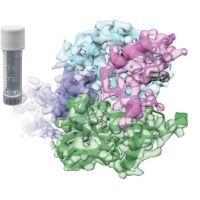Specification
| Description | Recombinant protein from the full-length sequence of Homo sapiens apolipoprotein B mRNA editing enzyme catalytic subunit 3G (APOBEC3G), transcript variant 1 (NM_021822). |
| Organism | Homo sapiens (Human) |
| Expression Host | Human Cells |
| Tag Info | His or DYKDDDDK. Please contact us if you need further information or require specific designed tag. |
| Purity | Greater than 90% by SDS-PAGE gel |
| Uniprot ID | Q9HC16 |
| Entry Name | ABC3G_HUMAN |
| Gene Names | APOBEC3G MDS019 |
| Alternative Gene Names | |
| Alternative Protein Names | DNA dC->dU-editing enzyme APOBEC-3G (EC 3.5.4.-) (APOBEC-related cytidine deaminase) (APOBEC-related protein) (ARCD) (APOBEC-related protein 9) (ARP-9) (CEM-15) (CEM15) (Deoxycytidine deaminase) (A3G) |
| Application | Antigens, Western, ELISA and other in vitro binding or in vivo functional assays, and protein-protein interaction studies; For research & development use only! |
| Buffer | Purified protein formulated in a sterile solution of PBS buffer, pH7.2, without any preservatives |
| Endotoxin | Endotoxin level is < 0.1 ng/µg of protein (<1EU /µg) |
| Length | 384 |
| Molecular Weight(Da) | 46408 |
| Protein Sequence | (The sequence of expressed protein may have some variation from the sequence shown below. Please contact us for the exact sequence.) MKPHFRNTVERMYRDTFSYNFYNRPILSRRNTVWLCYEVKTKGPSRPPLDAKIFRGQVYSELKYHPEMRFFHWFSKWRKLHRDQEYEVTWYISWSPCTKCTRDMATFLAEDPKVTLTIFVARLYYFWDPDYQEALRSLCQKRDGPRATMKIMNYDEFQHCWSKFVYSQRELFEPWNNLPKYYILLHIMLGEILRHSMDPPTFTFNFNNEPWVRGRHETYLCYEVERMHNDTWVLLNQRRGFLCNQAPHKHGFLEGRHAELCFLDVIPFWKLDLDQDYRVTCFTSWSPCFSCAQEMAKFISKNKHVSLCIFTARIYDDQGRCQEGLRTLAEAGAKISIMTYSEFKHCWDTFVDHQGCPFQPWDGLDEHSQDLSGRLRAILQNQEN |
Background
| Function | FUNCTION: DNA deaminase (cytidine deaminase) which acts as an inhibitor of retrovirus replication and retrotransposon mobility via deaminase-dependent and -independent mechanisms. Exhibits potent antiviral activity against Vif-deficient HIV-1. After the penetration of retroviral nucleocapsids into target cells of infection and the initiation of reverse transcription, it can induce the conversion of cytosine to uracil in the minus-sense single-strand viral DNA, leading to G-to-A hypermutations in the subsequent plus-strand viral DNA. The resultant detrimental levels of mutations in the proviral genome, along with a deamination-independent mechanism that works prior to the proviral integration, together exert efficient antiretroviral effects in infected target cells. Selectively targets single-stranded DNA and does not deaminate double-stranded DNA or single- or double-stranded RNA. Exhibits antiviral activity also against simian immunodeficiency viruses (SIVs), hepatitis B virus (HBV), equine infectious anemia virus (EIAV), xenotropic MuLV-related virus (XMRV) and simian foamy virus (SFV). May inhibit the mobility of LTR and non-LTR retrotransposons. {ECO:0000269|PubMed:12167863, ECO:0000269|PubMed:12808465, ECO:0000269|PubMed:12808466, ECO:0000269|PubMed:12809610, ECO:0000269|PubMed:12859895, ECO:0000269|PubMed:12970355, ECO:0000269|PubMed:14528300, ECO:0000269|PubMed:14557625, ECO:0000269|PubMed:15031497, ECO:0000269|PubMed:16378963, ECO:0000269|PubMed:16527742, ECO:0000269|PubMed:18288108, ECO:0000269|PubMed:19458006, ECO:0000269|PubMed:20219927, ECO:0000269|PubMed:20335265, ECO:0000269|PubMed:21123384, ECO:0000269|PubMed:21835787, ECO:0000269|PubMed:22791714, ECO:0000269|PubMed:22807680, ECO:0000269|PubMed:22915799, ECO:0000269|PubMed:23097438, ECO:0000269|PubMed:23152537}. |
| Pathway | |
| Protein Families | Cytidine and deoxycytidylate deaminase family |
| Tissue Specificity | Expressed in spleen, testes, ovary and peripheral blood leukocytes and CD4+ lymphocytes. Also expressed in non-permissive peripheral blood mononuclear cells, and several tumor cell lines; no expression detected in permissive lymphoid and non-lymphoid cell lines. Exists only in the LMM form in peripheral blood-derived resting CD4 T-cells and monocytes, both of which are refractory to HIV-1 infection. LMM is converted to a HMM complex when resting CD4 T-cells are activated or when monocytes are induced to differentiate into macrophages. This change correlates with increased susceptibility of these cells to HIV-1 infection. {ECO:0000269|PubMed:11863358, ECO:0000269|PubMed:12167863, ECO:0000269|PubMed:20308164}. |
QC Data
| Note | Please contact us for QC Data |
| Product Image (Reference Only) |  |

